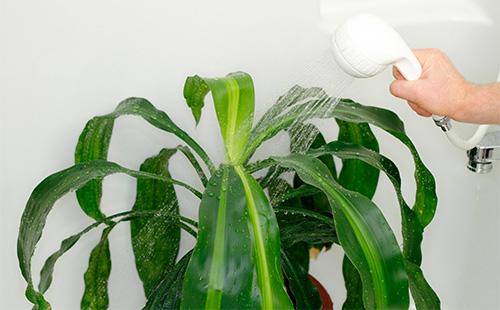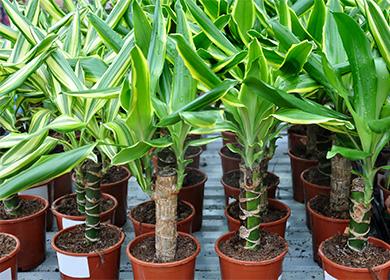The content of the article
This dracaena is called "indoor bamboo of happiness" or "bamboo lucky", although it has nothing to do with it. She received this name for the external similarity of a bare trunk with bamboo and the belief that Dracaena Sander brings good luck to the house.
Description and Features
The stalk is not leafy, smooth, with characteristic "bamboo" constrictions. The apartment grows meter high. It differs in small, short leaves - not more than 25 cm. In shape, the leaves are lanceolate-elongated with a glossy surface. To the touch are dense, tough.
The main species of Sander dracaena is evenly colored in light green. There are hybrid varieties with a more interesting color, with a dark or yellowish border on the edge of the leaf, stripes.
In stores you can see dracaena with spiral trunks. This is not a natural feature of the plant - this effect is achieved artificially. On an industrial scale, growing plants in special spiral curved tubes is practiced. After removal of the tube, the trunk remains spiral.
Where to settle
Growing Sander dracaena at home can be organized in several ways.
- In water. Choose a not too large vase. Soft, clean water is poured into it so that it covers the root system of the dracaena by 2 cm. In more water, the likelihood of decay of the stem appears. Fluid is changed every week. Top dressing is carried out by adding mineral fertilizers directly to the water.
- In the ground. Builds a powerful root system. For planting in a soil mixture, a not very wide, but rather high pot is chosen. The soil mixture is easier to buy in the store, rather than compiling on your own. The best option is a substrate for palm trees. At the bottom of the pot, a drainage layer of fine pebbles or expanded clay is necessarily poured. For the first time after planting, the stem may pucker. This is not necessary to be afraid - after adaptation in a new environment, the stems will again become smooth.
- In hydrogel. Dracaena looks very beautiful in transparent containers filled with decorative hydrogel. The hydrogel balls are pre-soaked according to the instructions, filled with a transparent glass vase, and the bamboo stems are placed in it.
Care for Dracaena Sander: what to consider
In addition to the original appearance, the clear advantage of Dracaena Sander is endurance. She easily tolerates numerous trimming, shaping. This kind of dracaena goes on sale in water. But many flower growers prefer to grow it according to standard agricultural techniques in a nutritious soil substrate. How to care for bamboo varnishes?
- Lighting. The place is chosen sufficiently lit, but without direct sunlight. It can grow with artificial lighting. Hybrid variegated varieties have a higher need for light, but they also do not like the sun. Sander’s dracaena is usually not kept on the windowsills - it’s too light for her.
- Temperature. The plant is thermophilic, but there is no need to maintain a strict temperature regime. The only requirement is that the temperature should not fall below 17 ° C even in winter. In summer, it calmly withstands an increase of up to 35 ° C. It is not recommended to take it out onto the balcony and garden. It transfers drafts normally - it is advisable to ventilate the room daily.
- Humidity. There are no special requirements for humidity levels. Dracaena Sander easily tolerates the dry air of apartments. Periodic spraying and wiping with a damp soft cloth are recommended as hygienic procedures to maintain leaf cleanliness.
- Watering. Dracaena growing in the soil is watered as necessary - when the top layer of the substrate is sufficiently dry. More than 3 cm is better not to dry. Dracaena reacts sharply to drought - it can die. When grown in an aqueous medium, the stability of the liquid level is monitored. Top up water or change it once a week. Particular attention is paid to water quality.
- Top dressing. When grown in an aqueous medium, a small amount of fertilizer is poured directly into the liquid. In a soil substrate, mineral substances are applied with water for irrigation to slightly moist soil. It is recommended to use special complex preparations for dracen. It is possible to feed with the preparation "Kemira-lux" popular among gardeners. Frequency of application - once a month. For plants in water, the dosage is reduced. They feed only during the period of active growth.
- Sander Dracaena Transplant. If the plant is grown in soil, it is periodically transplanted. Use the transshipment method so as not to injure the delicate root system. Transplanted with a frequency of 2-3 years.
How to spin a plant in a spiral
Dracaena Sander gives a special charm to an interesting shape - twisted into a spiral or intertwined stems. Judging by the reviews, it will not work to spin the dracaena on its own - fragile stems break. But you can try to use the following methods.
- Support fixing. A thick, even stick, cylinder or other suitable item is placed in the center of the pot. Young shoots neatly wrap around a support and are fixed by a wire. When the stem is completely lignified, the support is removed.
- Light access restriction. Germinated stalk is covered with an opaque box with one vertical window. A young shoot reaches for the light. As the shoot grows, the box is rotated. As a result, the barrel twists, but it can take about a year to form one turn.

Basic breeding methods
Bamboo happiness can only be propagated vegetatively. There are several methods of vegetative propagation.
Stem division
- The stem of an adult plant is cut into several parts.
- The upper sections are covered with soft wax or garden varnish so that a piece of the stem does not lose moisture.
- Prepared cuttings are placed in a glass with water.
- Seating indoor bamboo in separate pots is possible after the formation of a complete root system - after about two months.
Several plants from one cuttings
- The stalk is cut into longer cuttings.
- Stack them horizontally.
- The upper part of the sections from both ends is covered with wax or garden var.
- Regularly add a small amount of water.
- After the roots appear, the stalk can be transplanted into the substrate in the same position. Soon there will be several new shoots.
Rooting shoots
- Root any lateral apical shoot.
- Do this in water or in the ground.
- A slice on an adult plant is smeared. The soil is regularly moistened, and the water is changed.
How to get specimens from seeds
You can get several young copies of dracaena at once, indeed, you can sow seeds. The only difficulty is finding seeds in stores is not so easy. Germination process itself is laborious and lengthy. Spend it in four stages.
- The seeds are soaked before sowing. They are waiting for swelling and the appearance of small seedlings. For this, the seeds are wrapped in a damp cloth, kept warm, periodically sprayed with warm water from a spray bottle.
- Soil is prepared from sand, expanded clay and sheet earth. Components are taken in equal proportions. On the surface of the substrate, seeds are laid out, sprinkled with a thin layer of sand.
- The container is covered with a film. They put in a warm, bright place. Periodically, the film is slightly opened to air the greenhouses, the soil is sprayed from the spray gun.
- After emergence, the film is removed. At a height of seedlings of about 5 cm they are planted in separate pots. Only strong plants leave.

Possible problems
Problems with Dracaena occur infrequently. But sometimes, as a result of improper care, its decorativeness decreases. Common problems and their probable causes are shown in the table.
Table - Problems of growing Sander dracaena
| Problems | Probable reasons |
|---|---|
| Dracaena Sander turns yellow, roots soften | - Pitium (fungal disease); - did not change the water for a long time |
| Yellow or white spots appear on the leaves, the edges dry | - Temperature differences; - cold |
| The edges of the leaves become colorless and watery, the leaves fall off | - excess fluoride; - drafts |
| The trunk turns brown, softens | - Rot; - did not change the water for a long time; - dense soil; - excess watering |
| Leaves discolor, the trunk bends | - Lack or excess of light |
| Red-yellow spots appear (later turn black) | - cold; - insufficient lighting |
Of the pests, a spider mite, thrips, shields, mealybug and nematodes. It is very rare to encounter pests, since most of them are actively developing in dry air.
Caring for Dracaena Sander depends on the chosen method of cultivation. In the ground, it is not much different from caring for other indoor flowers, in the water it has its own characteristics. The plant is resistant to disease and improper care, unusual appearance, harmoniously fits into the modern design of the apartments.

